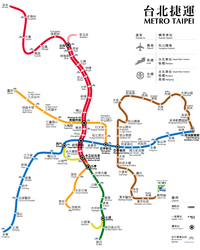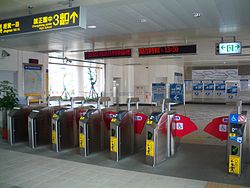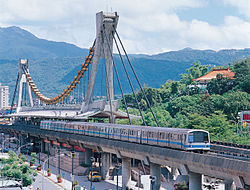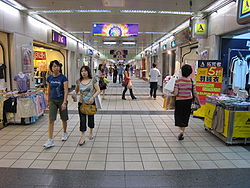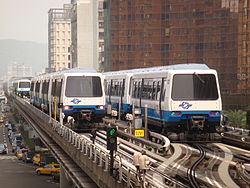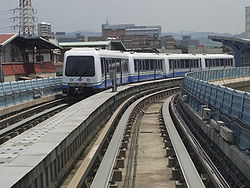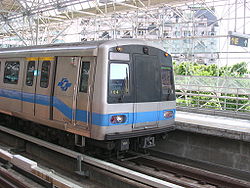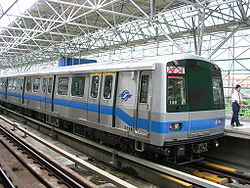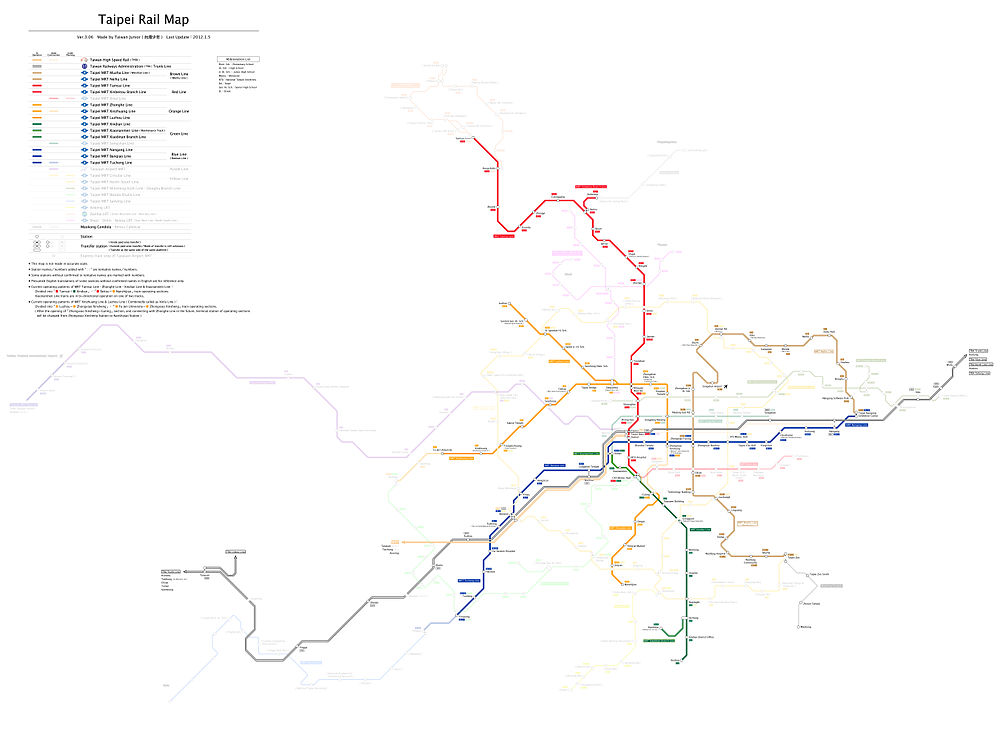- Taipei Metro
-
Taipei Metro
(Taipei Rapid Transit System)
Info Locale Taipei and New Taipei,
 Republic of China (Taiwan)
Republic of China (Taiwan)Transit type Rapid transit Number of lines 10[1][2] Number of stations 89 Daily ridership 1.38 million (2010)[3]
1.56 million (Oct. 2011)[3]Annual ridership 505.5 million (2010)[4] Headquarters 7, Lane 48, Sec. 2, Zhongshan N. Rd., 10448, Taipei City, Taiwan Operation Began operation March 28, 1996 Operator(s) Taipei Rapid Transit Corporation Technical Track gauge High-capacity: 1,435 mm (4 ft 8 1⁄2 in) (standard gauge)[5]
Medium-capacity: 1,880 mm (6 ft 2 in)[6]Minimum radius of curvature High-capacity: 200 m[7]
Medium-capacity: 30 m[7]Electrification Third rail 750 V DC Average speed High-capacity: 34 km/h
Medium-capacity: 33 km/h[7]Top speed High-capacity: 90 km/h
Medium-capacity: 80 km/h[7]System map Taipei Metro Traditional Chinese 台北大眾捷運系統 Simplified Chinese 台北大众捷运系统 Transcriptions Hakka - Romanization Thòi-pet Thai-zung Chia̍p-yun He-thúng Mandarin - Hanyu Pinyin Táiběi Dàzhòng Jiéyùn Xìtǒng - Tongyong Pinyin Táiběi Dàjhòng Jiéyùn Sìtǒng - Wade–Giles T'ai2-pei3 Ta4-chung4 Chieh2-yün4 Hsi4-t'ung3 - Bopomofo ㄊㄞˊ ㄅㄟˇ ㄉㄚˋ ㄓㄨㄥˋ ㄐ一ㄝˊ ㄩㄣˋ ㄒ一ˋ ㄊㄨㄥˇ Min - Hokkien POJ Tâi-pak Toā-chiòng Chia̍t-ūn Hē-thóng Taipei Metro Traditional Chinese 台北捷運 Simplified Chinese 台北捷运 Transcriptions Hakka - Romanization Thòi-pet Chia̍p-yun Mandarin - Hanyu Pinyin Táiběi Jiéyùn - Tongyong Pinyin Táiběi Jiéyùn - Wade–Giles T'ai2-pei3 Chieh2-yün4 - Bopomofo ㄊㄞˊ ㄅㄟˇ ㄐ一ㄝˊ ㄩㄣˋ Min - Hokkien POJ Tâi-pak Chia̍t-ūn Second alternative Chinese name Traditional Chinese 台北大眾捷運公司 Simplified Chinese 台北大众捷运公司 Transcriptions Mandarin - Hanyu Pinyin Táiběi Dàzhòng Jiéyùn Gōngsī - Bopomofo ㄊㄞˊ ㄅㄟˇ ㄉㄚˋ ㄓㄨㄥˋ ㄐ一ㄝˊ ㄩㄣˋ ㄍㄨㄥ ㄙ The Taipei Metro, more commonly known as the MRT or formally as the Taipei Rapid Transit System, is a rapid transit system serving metropolitan Taipei in Taiwan. The system is built and operated by the Taipei Rapid Transit Corporation (TRTC) and consists of 89 stations and 101.9 km (63.3 mi) of revenue track. The system carried an average of over 1.6 million passengers per day in December 2010.[3]
The Taipei Metro is Taiwan's first metro system.[8] Since it first began operations in 1996, the system has been effective in relieving some of Taipei's traffic congestion problems.[9] The system has also proved effective as a catalyst for urban renewal, as well as increasing tourist traffic to outlying cities such as Tamsui. Conversions to existing railway lines were made to integrate them into the metro system.
Contents
Network and operations
The system operates according to a spoke-hub distribution paradigm, with most rail lines running radially outward from central Taipei. The MRT system operates from 6 am to midnight daily,[10] with extended services during special events (such as New Year festivities).[11] Trains operate at intervals of 1.5 to 15 minutes depending on the line and time of day.[10][12] Smoking is forbidden in the entire metro system, while eating, drinking, chewing gum, and betel nuts are forbidden within the yellow line of each station.[13]
Stations become extremely crowded during rush hours, especially at transfer stations such as Taipei Main Station, Zhongxiao Fuxing, and Minquan West Road. Automated station announcements are recorded in Mandarin, Taiwanese, Hakka, and English.[14]
Lines
Line Opening Date Termini Stations Length (km) Depot Brown Neihu Jul. 4, 2009 Taipei Nangang
Exhibition CenterZhongshan Junior
High School12 14.8 Neihu
MuzhaWenshan Mar. 28, 1996 Zhongshan Junior
High SchoolTaipei Zoo 12 10.9 Red Tamsui Dec. 25, 1997 Tamsui CKS Memorial Hall 20 23.2 Beitou Xinbeitou Branch Dec. 25, 1997 Beitou Xinbeitou 1 1.2 Orange Zhonghe Dec. 25, 1998 Nanshijiao Guting 4 5.4 Zhonghe Xinzhuang Nov. 3, 2010 Zhongxiao Xinsheng Daqiaotou 6 5.2 Luzhou Luzhou Daqiaotou Luzhou 5 6.4 Green Xiaonanmen Aug. 31, 2000 Ximen CKS Memorial Hall 1 1.6 Xindian Xindian Nov. 11, 1999 CKS Memorial Hall Xindian 11 9.3 Xiaobitan Branch Sep. 29, 2004 Qizhang Xiaobitan 1 1.9 Blue Nangang Eastern
Extension[15]Dec. 25, 2008
Feb. 27, 2011Taipei Nangang
Exhibition CenterKunyang 2 2.5 Nangang
TuchengNangang
Banqiao
(Bannan)Dec. 29, 2000 Kunyang Taipei City Hall 3 2.8 Dec. 24, 1999 Taipei City Hall Longshan Temple 9 7.5 Aug. 31, 2000 Longshan Temple Xinpu 2 3.6 Banqiao
Tucheng[15]May 31, 2006 Xinpu Yongning 6 5.5 Note: Tamsui was previously known as Danshui. Train operating routes
- Nangang, Banqiao, and Tucheng Lines connect through to each other. Service routes are divided into [Taipei Nangang Exhibition Center - Yongning] and [Taipei Nangang Exhibition Center - Far Eastern Hospital]. During rush hour, trials are being run on a [Zhongxiao Fuxing - Far Eastern Hospital] route.
- Although part of the Orange Line, the Xinzhuang and Luzhou Lines currently run on a separate route: [Zhongxiao Xinsheng - Luzhou]
- Tamsui and Xindian Lines connect through to each other: [Tamsui - Xindian].
- Tamsui and Zhonghe Lines connect through to each other: [Beitou - Nanshijiao]. After 11 PM, the route is shortened to [Taipei Main Station - Nanshijiao]. During peak holiday periods, trials are being run for [Tamsui - Nanshijiao].
- The above are two two-way routes and utilize six-car configurations.
- Xiaobitan Branch Line: [Xiaobitan - Qizhang]
- Xiaonanmen Line: [Ximen - Chiang Kai-shek Memorial Hall].
- Xinbeitou Line: [Beitou - Xinbeitou].
- The above are short-range, two-way operations. The Xiaonanmen Line utilizes six-car configurations, while the Xinbeitou and Xiaobitan Lines utilize three-car configurations.
- The Wenshan-Neihu Line connect through to each other: [Taipei Nangang Exhibition Center - Taipei Zoo]. The route utilizes four-car configurations, although the platform lengths allow for six-car configurations.
Fares and tickets
RFID IC Tokens and EasyCard smart cards are used to collect fares for day-to-day use, with the exception of group tickets and bicycle access tickets (which use paper tickets).[16] The Kaohsiung MRT Card and Taiwan Smart Card will begin to be accepted by the end of 2011 with the installation of multiple card readers.[17]
Fares range from NT$20 to NT$65 with most locations accessible for around NT$20–30. Beginning April 1, 2011, senior citizens and physically challenged individuals will be entitled to a 50% discount on fares.[18] The fare for the first 5 km on a one-way ticket is NT$20, and each additional 3 km costs an extra NT$5, up to NT$65.[19] A 20% discount is taken with use of an EasyCard. The table below shows fare amounts versus distance.
Distance
(km)≤5 5~8 8~11 11~14 14~17 17~20 20~23 23~27 27~31 ≥31 Fare
(NT$)20 25 30 35 40 45 50 55 60 65 Fare using EasyCard 16 20 24 28 32 36 40 44 48 52 Types of tickets
- IC Tokens: These single-use RFID tokens can be bought from ticket vending machines in each station.[16] They are valid only on the day of purchase and replaced the existing magnetic cards in 2007.[20]
- One-Day Pass: This card allows for unlimited Taipei Metro travel. They are valid from the first use until the end of service on the same day (not including the Maokong Gondola).[16] Value cannot be added and it costs NT$200 (inclusive of a NT$50 deposit). The deposit can be collected if the card is returned within three days of the first use.
- Paper tickets are no longer being issued. However, they can be obtained in exchange for a Taipei Metro gift coupon.
- Group Ticket: These are available for groups of 10 or more (at a 20% discount) or groups of 40 or more (at a 30% discount).[16] These cannot be refunded once issued and require passengers to enter through the "Group Ticket Entrance/Exit".
- Single Journey Ticket for Cyclists: At a cost of NT$80, this allows for one person to bring a bicycle into the system (at select stations).[16] It is only issued/valid at certain times, and no funds can be given once issued. In 2008, 102,279 bicycles were taken on the Taipei Metro.[7]
- EasyCard: Issued by the EasyCard Corporation, these cards are stored value cards for contactless electronic payment. They are available as Adult, Student, Concessionaire, and TaipeiPass varieties. See Types of EasyCards for more information.
- Senior EasyCard passengers enjoy a 60% discount on base fares.[16] Easy Card users receive half-price discounts automatically on connecting bus routes from and towards the Metro stations.
History
The Taipei Metro is one of the most expensive rapid transit systems ever constructed,[21] with Phase One of the system costing US$18 billion[22] and Phase Two (currently under construction) estimated to cost US$13.8 billion upon completion.
Initial proposal
In 1967, the government of the Republic of China began researching the possibility of constructing a rapid transit network in the Taipei metropolitan area; however, the plan was shelved due to fiscal concerns and the belief that such a system was not urgently needed at the time. With the increase of traffic congestion accompanying economic growth in the 1970s, the need for a rapid transit system became more pressing.[23] In February 1977, the Institute of Transportation (IOT) of the Ministry of Transportation and Communications (MOTC) released a preliminary rapid transport system report, with the designs of five lines, including U1, U2, U3, S1, and S2, to form a rough sketch of the planned corridors, resulting in the first rapid transit system plan for Taipei.[24]
In 1981, the IOT invited British Mass Transit Consultants (BMTC) and China Engineering Consultants, Inc. to form a team and provide in-depth research on the preliminary report.[24] In 1982, the Taipei City Government commissioned National Chiao Tung University to do a research and feasibility study on medium-capacity rapid transit systems. In January 1984, the university proposed an initial design for a medium-capacity rapid transit system in Taipei City, including plans for Line 1 and Line 2 of the medium-capacity metro system.[24] On March 1, 1985, the Executive Yuan Council for Economic Planning and Development (CEPD) signed a treaty with the Taipei Transit Council (TTC), composed of three American consultant firms, to do overall research on a rapid transit system in metropolitan Taipei. Apart from adjustments made to the initial proposal, Line 1 of the medium-capacity metro system was also included into the network. In 1986, the initial network design of the Taipei Metro by the CEPD was passed by the Executive Yuan, although the network corridors were not yet set.[25] A budget of NT$441.7 billion (US$13.4 billion) was allocated for the project.[26]
On June 27, 1986, the Preparatory Office of Rapid Transit Systems was created,[22] which in 1987 was formally established as the Department of Rapid Transit Systems (DORTS) for the task of handling planning, design, and construction of the system.[26] Apart from preparing for the construction of the metro system, DORTS also made small changes to the metro corridor. The 6 lines proposed on the initial network were:[24] Tamsui Line, Xindian Line, Zhonghe Line, Nangang Line, Banqiao Line, and Muzha (now Wenshan) Line, totaling 79 stations and 76.8 km (47.7 mi) route length,[26] including 34.4 km (21.4 mi) of elevated rail, 9.5 km (5.9 mi) at ground level, and 44.2 km (27.5 mi) underground.[22] The Neihu Line corridor was approved later in 1990.
The six lines
 Wende Station platform on the Neihu Line, an extension of the Wenshan Line and one of the original planned lines.
Wende Station platform on the Neihu Line, an extension of the Wenshan Line and one of the original planned lines.
The Executive Yuan approved the initial network plan for the system on May 27, 1986.[25] Ground was broken and construction began on December 15, 1988.[25] The growing traffic problems of the time, compounded by road closures due to TRTS construction led to what became popularly known as the "Dark Age of Taipei Traffic". The TRTS was the center of political controversy during its construction and shortly after the opening of its first line in 1996 due to incidents such as computer malfunction during a thunderstorm, alleged structural problems in some elevated segments, budget overruns, and fare prices.
The system opened on March 28, 1996, with the 10.5 km (6.5 mi) elevated Muzha Line, a driverless, medium-capacity line[25] with twelve stations running from Zhongshan Junior High School to Taipei Zoo. The first high-capacity line, the Tamsui Line, began service on March 28, 1997, running from Tamsui to Zhongshan Station. On December 23, 1998, the system passed the milestone of 100 million passengers.[27]
On December 24, 1999, a section of the Banqiao/Nangang Line was opened between Longshan Temple and Taipei City Hall.[25] This section became the first east-west line running through the city, connecting the two previously completed north-south lines. On May 31, 2006, the second stage of the Banqiao/Nangang Line and the Tucheng Line began operation.[25]
On July 4, 2009, with the opening of the Neihu Line, the last of the six original lines was completed. Due to controversy on whether to construct a medium-capacity or high-capacity line, construction of the line did not begin until 2002.[28]
Important events
On September 17, 2001, Typhoon Nari flooded all underground tracks as well as 16 stations, the heavy-capacity system operation control center, the administration building, and the Nangang Depot.[29] The elevated Muzha Line was not seriously affected and resumed operations the next day.[9] However, the heavy-capacity lines were not restored to full operational status until three months later. Following this incident, TRTS has devoted more resources to flood prevention in the underground system.
On July 4, 2007, the Maokong Gondola, a new aerial lift/cable-car system, was opened to public. The system connects Taipei Zoo, Chi Nan Temple, and Maokong. Service was suspended on October 1, 2008 due to erosion from mudslides under a support pillar.[30] The gondola officially resumed service as of March 31, 2010, after relocation of the pillar and passing safety inspections.[31]
On New Year's Eve 2009 and New Year's Day 2010, the Metro system transported 2.17 million passengers in 42 consecutive hours. On April 22, 2010 after 14 years of service, the system achieved the milestone of 4 billion cumulative riders.[32] On December 29, 2010, the system passed the benchmark of 500 million annual passengers for the first time.[33] The record for single day ridership hit 2.5 million passengers during the New Year's Eve celebrations on December 31, 2010.[34][35]
Impact
Despite earlier controversy, by the time the first phase of construction was completed in 2000, it was generally agreed that the metro project was a success and has since become an essential part of life in Taipei. The system has been effective in reducing traffic congestion in the city and has spurred the revival of satellite towns (like Tamsui) and development of new areas (like Nangang).[9][36] The system has also helped to increase average vehicle speed for routes running from New Taipei into Taipei.[37] Property prices along metro routes (both new and existing) tend to increase with the opening of more lines.[38][39]
Since the Taipei Metro joined the Nova International Railway Benchmarking Group and the Community of Metros (Nova/CoMET) in 2002, it has started collecting and analyzing data of the 33 Key Performance Indicators set by Nova/CoMET in order to compare them with those of other metro systems around the world, as a reference to improve its operation. Taipei Metro also has gained keys to success from case studies on different subjects such as safety, reliability, and incidents, and from the operational experiences of other metro systems.[40]
According to a study conducted by the Railway Technology Strategy Centre of Imperial College,[41] and data gathered by Nova/CoMET, the Taipei Metro has ranked number 1 in the world for four consecutive years in terms of reliability, safety, and quality standards (2004–2007).[7]
Facilities
Stations
The Taipei Metro provides an obstacle-free environment within the entire system; all stations and trains are handicap accessible. Features include:[42][43][44] handicap-capable restrooms, ramps and elevators for wheelchairs and strollers, tactile guide paths, extra-wide faregates, and trains with a designated wheelchair area.[45]
To accommodate increasing passenger numbers, all metro stations have replaced turnstiles with speedgates since 2007, and single journey magnetic cards have been replaced by RFID tokens.[20] TRTS provides free mobile phone connections in all stations, trains, and tunnels and also provides WiFi WLAN connections at several station hotspots.[46] The world's first WiMAX-service metro trains were introduced on the Wenshan Line in 2007, allowing passengers to access the internet and watch live broadcasts.[47]
Platforms
Most stations on high-capacity lines have island platform configurations while a few have side platform configurations, and vice versa for medium-capacity lines. All high-capacity metro stations have a 150 m (490 ft) long platform to accommodate all six train cars on a typical metro train (with the exception of Xiaobitan). The width of the platform and concourse depends on the volume of transit; the largest stations include Taipei Main Station, Zhongxiao Fuxing, and Taipei City Hall. Some future transfer stations, including Chiang Kai-shek Memorial Hall, Guting, and Songjiang Nanjing, also have wide platforms.
Each station is equipped with LED displays and LCD TVs both in the concourse and on the platforms which display the time of arrival of the next train. At all underground stations, red lights along the platform edge (or on automatic platform gates at stations where they are installed) flash one minute prior to train arrival to alert passengers.
All the stations on the Brown Line and Xinzhuang/Luzhou Lines, as well as at Taipei Nangang Exhibition Center, are equipped with platform screen doors. High-traffic stations, including Taipei Main Station, Zhongxiao Fuxing, and Taipei City Hall,[48][49] have platform gates to prevent passengers and other objects from falling onto the rails.[7] For safety reasons, fifteen additional stations will be equipped with these gates in the future (including Ximen, Guting, and Banqiao).[50][51] All lines and extensions currently under construction will be equipped with platform screen doors. A Track Intrusion Detection System has also been installed to improve passenger safety at stations without platform doors.[7] The system uses infrared and radio detectors to monitor unusual movement in the track area.[52]
The East Metro Mall is an underground mall which connects between Zhongxiao Fuxing and Zhongxiao Dunhua.
Shopping centers
In addition to the rapid transit system itself, the TRTC operates several public facilities such as underground shopping malls, parks, and public squares in and around stations,[53] including:
- Zhongshan Metro Mall: Shuanglian Station - Zhongshan Station - Taipei Main Station (815 m, 81 shops).[7]
- Taipei Main Station Underground Mall: on floor B1 of the station.
- Taipei New World Shopping Center: Between the metro and TRA sections of Taipei Station.
- Station Front Mall: West of Taipei Main Station, beneath Zhongxiao W. Road.
- Taipei Underground Market: Northwest of Taipei Main Station, beneath Zhengzhou Rd. and Civic Blvd.
- East Metro Mall: Between Zhongxiao Fuxing Station and Zhongxiao Dunhua Station (825 m, 35 shops).[7][54]
- Ximen Underground Mall: north of Ximen Station (currently used as an office building and library).
- Longshan Temple Underground Mall: Longshan Temple Station north and south sides.
- Global Mall: Banqiao Station floors B1 to 2F.
As of 2008 there are 102 shops within the stations themselves.[7]
 Public artwork by Jimmy Liao on the Nangang Station platform.
Public artwork by Jimmy Liao on the Nangang Station platform.
Public art
In the initial network, important stations such as transfer stations, terminal stations, and stations with heavy passenger flow were chosen for the installation of public art. The principles behind the locations of public art were visual focus and non-interference with passenger circulation and construction schedules. The artworks included murals, children's mosaic collages, sculptures, hung forms, spatial art, interactive art, and window displays. The selection methods included open competitions, invitational competitions, direct assignments, and cooperation with children.
Stations with public art displays include: Shuanglian, National Taiwan University Hospital, Chiang Kai-shek Memorial Hall, Guting, Gongguan, Xindian, Xiaobitan, Dingxi, Nanshijiao, Taipei City Hall, Kunyang, Nangang, Haishan, and Tucheng. Stations with art galleries include Zhongshan, Chiang Kai-shek Memorial Hall, Zhongxiao Fuxing, and Taipei Main Station.
The promotion for artwork continues today - the Department of Rapid Transit held a bid on providing public large scale artwork for the interiors of the forthcoming Sanchong Station. The bid is placed at over NTD 9 million.[55]
Transit
Transfers to city bus stations are available at all metro stations. In 2009, transfer volume between the metro and bus systems reached 421,100 transfers per day (counting only EasyCard users).[56] Connections to Taiwan Railway Administration trains are available at Taipei Main Station, Banqiao, and Nangang. Connections to Taiwan High Speed Rail are served by Taipei Main Station and Banqiao (with future service to Nangang under construction). Connections to Taipei Bus Station and Taipei City Hall Bus Station are available at Taipei Main Station and Taipei City Hall Station, respectively. The Maokong Gondola is accessible from Taipei Zoo.
Taipei Songshan Airport is served by the Songshan Airport Station.[57] A metro system to connect Taipei to Taoyuan International Airport is currently under construction and is expected to be completed by 2013. Lines currently under construction will connect the system to additional TRA and THSR transfer stations.
Rolling stock
Rolling stocks on the Taipei Metro are multiple unit rolling stocks, using a third rail to provide electricity (750 volts DC) for propulsion. Each train is equipped with automatic train operation (ATO) for a partial or complete automatic train piloting and driverless functions.
Medium-capacity trains
The medium-capacity trains are rubber-tired trains with no onboard train operators but are operated remotely by the medium-capacity system operation control center. The Wenshan-Neihu Line uses a fixed-block Automatic Train Control (ATC) system. Each train consists of two 2-car Electric Multiple Unit (EMU) sets, with a total of 4 cars.[58] Each car is separate and not interconnected; passengers cannot walk between cars except when the train stops at a station.
The Wenshan Line previously used the VAL 256 trains cars, with the two VAL 256 cars in the same set sharing the same road number. As a result of this numbering scheme, the 102 cars of the VAL fleet have car numbers from 1 to 51. On June 2003, Bombardier was awarded a contract to supply the Neihu Line with 202 Innovia 256 train cars [1], installing the communications-based CITYFLO 650 moving-block ATC system to replace the current fixed-block ATC and retrofitting the existing 102 VAL 256 cars with the CITYFLO 650 ATC system. Integration of Bombardier's trains with the existing Brown Line has proven to be difficult at the beginning, with multiple system malfunctions and failures during the first three months of operation.[59] Retrofitting older trains also took longer than expected, as the trains must also undergo several hours of reliability testing during non-service hours. The VAL 256 trains resumed operations since December 2010.
Heavy-capacity trains
The heavy-capacity trains have steel wheels and are operated by an on-board train operator. The trains are computer-controlled. The operator, who is both motorman and conductor, is responsible for opening and closing the doors and making announcements. ATC controls all train movements - braking, acceleration and speed control, but can be manually overridden by the operator in the case of an emergency.
Each train consists of two 3-car Electric Multiple Unit (EMU) sets with a total of 6 cars.[58] Each 3-car EMU set is permanently coupled as DM-T-M, where DM is the motor car with cab, T is a trailer car and M is the motor car without cab. Each motor car has two AC traction motors. The configuration of a 6-car train is DM-T-M-M-T-DM. All cars are interconnected by passage links to allow passengers to pass freely between cars.
In Set XXX, the road number of a DM car is 1XXX, the road number of a T car is 2XXX and the road number of an M car is 3XXX. The table below shows the set numbers of the heavy-capacity car types, which include Types C301, C321, C341 and C371. For example, if the car numbers of a C301 train is 1001-2001-3001-3002-2002-1002, two C301 sets 001 and 002 form this train.
A single set cannot be in revenue service except C371 single sets 397-399, where their M car is exactly a DM car despite its car number being 3XXX. These single sets run exclusively on Xinbeitou Branch Line and Xiaobitan Branch Line.[60] Before the C371 single sets were in revenue service on July 22, 2006, the M cars of C301 sets 013-014 were converted to temporary cab cars to run the Xinbeitou Branch Line.
In 2010, the new C381 was built for Taipei Metro to cope with increasing passenger ridership and the expansion of its network route. However, since its delivery the train sets have yet to be put into service, though some are planned for use with the future Xinyi and Songshan Lines.
Fleet roster
Car
TypeYear
BuiltBuilder Car
Length/
Width/
HeightSeating
capacity
per carTotal
capacity
Per carMax.
speedFleet
totalCar numbers Lines
currently onDenotes VAL
2561993 Matra 13.78 m/
2.56 m/
3.53 m24 114 80
km/h102 MP 1-51[61] ATC
retrofit
completed;
under
testing2-car set Innovia 256 2006- Bombardier 13.78 m/
2.54 m/
3.53 m20 142 80
km/h202 MP 101-201[61] Wenshan Line
Neihu Line2-car set C301 1992-
1993URC
(Subsidiary
of Kawasaki)23.5 m/
3.2 m/
3.6 m60 368 90
km/h132 1001-1044 (DM[62])
2001-2044 (T[63])
3001-3044 (M[64])All heavy-
capacity lines3-car set (DM-T-M)[65]
Set no.: 001-044C321 1997-
1999Siemens AG 23.5 m/
3.2 m/
3.6 m60 368 90
km/h216 1101-1172 (DM)
2101-2172 (T)
3101-3172 (M)All heavy-
capacity lines3-car set (DM-T-M)[66]
Set no.: 101-172C341 2003 Siemens AG 23.5 m/
3.2 m/
3.6 m60 368 90
km/h36 1201-1212 (DM)
2201-2212 (T)
3201-3212 (M)Banqiao –
Nangang Line
Tucheng Line3-car set (DM-T-M)[67]
Set no.: 201-212C371 2006-
2010Kawasaki 23.5 m/
3.2 m/
3.6 m60 368 90
km/h321 1301–1338,
1397-1399,
1401-1466 (DM)
2301-2338,
2397-2399,
2401-2466 (T)
3301-3338,
3397-3399,[68]
3401-3466 (M)All heavy-
capacity lines3-car set (DM-T-M)[69]
Set no.: 301-338,
397-399, 401-466C381 2010- Kawasaki 23.5 m/
3.2 m/
3.6 m60 368 90
km/h138 1501-1546 (DM)
2501-2546 (T)
3501-3546 (M)All heavy-
capacity lines3-car set (DM-T-M)[70]
Set no.: 501-546Depots
The system currently has 8 depots, with more under construction.[71]
Depot Name Year Opened Location Rolling Stock Housed Line(s) Served Muzha 1996 Wenshan, northeast of Taipei Zoo Station CITYFLO 650, VAL256 Wenshan Line Beitou 1997 Beitou, southwest of Fuxinggang Station Kawasaki C301, C371 Tamsui Line
Xinbeitou Branch LineZhonghe 1998 Zhonghe, east of Nanshijiao Station Kawasaki C301, C371 Zhonghe Line Xindian 1999 Xindian, northwest of Xiaobitan Station Kawasaki C301, C371
Siemens C321, C341Xindian Line
Xiaobitan Branch LineNangang 2000 Nangang, southeast of Kunyang Station Siemens C321, C341 Nangang Line Tucheng 2006 Tucheng, southwest of Far Eastern Hospital Station Siemens C321, C341 Tucheng Line Neihu 2009 Nangang, northeast of Taipei Nangang Exhibition Center Station CITYFLO 650 Neihu Line Luzhou 2010 Luzhou, northeast of Luzhou Station Kawasaki C371 Luzhou Line Future expansion
Lines approved and under construction
The following lines and segments are currently under construction:[15][72][73][74]
Line Planned opening date Termini Stations Length (km) Depot Orange Line Xinzhuang Line March 2012 Fu Jen University Daqiaotou 7 Xinzhuang June 2012 Zhongxiao Xinsheng Guting 1 2.6 Red Line Xinyi Line December 2012 CKS Memorial Hall Elephant Mountain 7 6.4 Beitou Taoyuan Airport MRT June 2013 Sanchong Huanbei 22 51.03 Luzhu Blue Line Tucheng Line December 2013 Yongning Dingpu 1 2.0 Tucheng Green Line Songshan Line December 2013 Songshan Ximen 8 8.5 Xindian Taoyuan Airport MRT October 2014 Taipei Main Station Sanchong 0 4[75] Luzhu Orange Line Xinzhuang Line November 2014 Huilong Fu Jen University 2 Xinzhuang Yellow Line Circular Line Stage 1 December 2015 New Taipei Industrial Park Dapinglin 14 15.4 South Red Line Xinyi Eastern
ExtensionDecember 2017 Elephant Mountain Zhongpo 2 1.6 Beitou Wanda-Zhonghe-Shulin Line December 2018 CKS Memorial Hall Zhonghe Senior
High School9 8.8 Xinzhuang Line
Main article: Xinzhuang LineThe Xinzhuang Line is a high-capacity underground extension of the Zhonghe Line currently under construction. As of May 2011, it is 93.23% complete.[76] The Xinzhuang Line is the first Taipei Metro line to cross under the Tamsui River. The section between Zhongxiao Xinsheng and Daqiaotou opened on November 3, 2010, along with the opening of the Luzhou Branch Line,[77] while the section between Guting and Zhongxiao Xinsheng is expected to open in 2012.
Xinyi Line
Main article: Xinyi LineThe Xinyi Line is a high-capacity, underground line currently under construction. It is the extension of the Tamsui Line and part of the Red Line. Upon completion, the line will alleviate congestion on the Nangang Line by providing another east-west route through the Xinyi District. The line will span 6.4 km (4.0 mi) and have 7 underground stations, running from Chiang Kai-shek Memorial Hall to Elephant Mountain.[78] A planned extension of the line will extend the line east along Xinyi Rd. and Fude Rd. to Zhongpo South Rd., and end at Yucheng Park. It will add 2 stations and 1.6 km of additional route length. The final corridor was approved on February 12, 2010.[79]
Taoyuan Airport MRT
Main article: Taoyuan International Airport MRTThe Taoyuan International Airport MRT is a rapid transit line planned to connect Taipei and Taiwan Taoyuan International Airport, before linking up with the Taoyuan MRT to THSR Taoyuan Station and onwards to Zhongli. Construction began in 2006 and the system is scheduled to begin service in June 2013.[80] The route will be 51.03 km (31.71 mi)-long with 7 underground stations, 15 elevated stations, and two maintenance depots (Chingpu and Lujhu). Elevated track makes up 40.11 km (24.92 mi) of the total route length.[81] The total budget for the project is NT$93.6 billion.[82] As of December 2010, the project is 66.21% complete.[83] Upon completion, the line is expected to serve over 143,000 passengers per day.[84] The entire system is expected to cost NT$113.85 billion.[80]
Songshan Line
Main article: Songshan LineThe Songshan Line is a high-capacity, underground line currently under construction. It is an extension of the Xindian (Sindian) Line. When completed, it will help ease congestion on the east-west Nangang Line. The 8.5 km (5.3 mi) route will have seven underground stations (including Ximen).[85] Upon completion, it will take 15 minutes to travel from Songshan to Ximen.[85] It is expected to open for service by December 2013.[86]
Tucheng Line extension
Main article: Tucheng LineA 2 km (1.2 mi)-extension of the Tucheng Line to Dingpu is under construction and expected to be completed by December 2013.[87] Upon completion, it will become the western terminus of the Blue Line.
Circular Line
Main article: Circular LineThe Circular Line is an elevated, medium-capacity line currently under construction in New Taipei. The first section is scheduled to open in 2015. Stage I construction consists of the section from New Taipei Industrial Park to Dapinglin on the Xindian Line and will be about 15.4 km (9.6 mi) long with 14 stations.[88] Ansaldo STS will supply electromechanical equipment for the line, including driverless technology and CBTC Radio signalling.[89]
Planned lines
The following lines are currently in the planning stages:[90]
Line Termini Stations Length (km) Depot Yellow Line Circular Line North Section Jiannan Road Business Exhibition Center 11 14.3 East Circular Line South Section Dapinglin Taipei Zoo 6 5.6 Ankeng Line Shisizhang Erbazi Botanical Garden 10 7.8 Erbazi Sanying Line Dingpu Pade 14 18.6 Minsheng-Xizhi Line Dadaocheng Xizhi 15 17.52 Xizhi Shezi, Shilin, and Beitou Light Rail Lines Shezi Tianmu 11 8.8 Beitou Daqiaotou 10 9.1 North-South Line Jiannan Road Xiulong Bridge 16 17.1 Shenkeng Line Taipei Zoo Shiding Service Area 6 7.8 Wanda-Zhonghe-Shulin Line Zhonghe Senior
High SchoolHuilong 13 13.3 Minsheng-Xizhi Line
As of February 2011, New Taipei has been pursuing the construction of the 17.52-km Minsheng-Xizhi Line, though the most recent plan was rejected by the Ministry of Transportation and Communications, citing the need for further evidence for the line's viability.[91] The city plans to re-submit the proposal, and the project is estimated to cost NT$42.2 billion (US$1.44 billion).[91] A possible 4.25-km extension of the line to Keelung is also being considered.[92]
See also
- Maokong Gondola
- Taiwan Taoyuan International Airport Access MRT System
- Kaohsiung Mass Rapid Transit
- Rail transport in Taiwan
- List of rapid transit systems
References and notes
- ^ Although the Taipei Metro has 10 "lines" with their own names, there are actually 5 main "routes" (i.e. "services"), not including branches - Xiaonanmen, Xiaobitan and Beitou - that belong to the MRT system. See also the difference between "lines" and "routes".
- ^ a b "Network and Systems". Taipei Rapid Transit Corporation. 2009-07-17. http://english.trtc.com.tw/lp.asp?ctNode=11758&CtUnit=5601&BaseDSD=7&mp=122032. Retrieved 2010-07-14.
- ^ a b c "Transport Volume Statistics". http://english.trtc.com.tw/ct.asp?xItem=1056489&ctNode=11767&mp=122032.
- ^ "Are Asia's Subway On Track?". The Straits Times: pp. C12. 20 August 2011.
- ^ "捷運百科—軌道工程(台北市捷運工程局)". http://www2.dorts.gov.tw/tech/cyclo8.asp. Retrieved 2011-01-07.
- ^ 內湖線則採用膠輪/鋼軌系統,中心線間距為1,880mm。此外,木柵線因採膠輪/水泥軌道系統,一般來說並無軌距之分,但其凸出於路面的兩條行車水泥軌枕,中心線間距為1,880mm。
- ^ a b c d e f g h i j k "Taipei Rapid Transit Corporation '08 Annual Report". Taipei Rapid Transit Corporation. http://english.trtc.com.tw/public/Attachment/9112716543575.pdf. Retrieved 2010-05-01.
- ^ "Taipei Subway Ranks as one of the Best". Wired. 2007-10-15. http://www.wired.com/autopia/2007/10/taipei-subway-r/. Retrieved 2010-03-13.
- ^ a b c "Traffic nightmares plague Taipei". The China Post. 2001-09-20. http://www.chinapost.com.tw/taiwan/detail.asp?onNews=1&GRP=D&id=17269. Retrieved 2010-06-30.
- ^ a b "Metro Service: Danshui-Xindian Line". Taipei Rapid Transit Corporation. 2010-10-16. http://english.trtc.com.tw/ct.asp?xItem=1056501&ctNode=27495&mp=122032. Retrieved 2010-07-04.
- ^ Mo Yan-chih (2010-12-29). "New Year's Eve revelers urged to use mass transit". Taipei Times. http://www.taipeitimes.com/News/taiwan/archives/2010/12/29/2003492153. Retrieved 2010-12-31.
- ^ "One train per 90 seconds on Neihu Line during peak hour: mayor". Taiwan News Online. 2009-07-05. http://www.etaiwannews.com/etn/news_content.php?id=995175. Retrieved 2009-08-16.
- ^ "Regulations for Use of the Taipei Metro System". Taipei Rapid Transit Corporation. 2009-10-14. http://english.trtc.com.tw/ct.asp?xItem=1056553&ctNode=11766&mp=122032. Retrieved 2010-07-04.
- ^ "FAQ: Systems and Operation". Taipei Rapid Transit Corporation. 2009-07-07. http://english.trtc.com.tw/lp.asp?CtNode=11770&CtUnit=5343&BaseDSD=7&mp=122032&xq_xCat=05. Retrieved 2010-07-04.
- ^ a b c "Second Stage of Taipei MRT (Approved MRT Routes)". Department of Rapid Transit Systems, TCG. 2010-03-12. http://english.dorts.taipei.gov.tw/ct.asp?xItem=205658&ctNode=19582&mp=115002. Retrieved 2010-04-21.
- ^ a b c d e f "Metro Tickets". Taipei Rapid Transit Corporation. 2009-12-18. http://english.trtc.com.tw/ct.asp?xItem=1056512&CtNode=33389&mp=122032. Retrieved 2010-07-04.
- ^ "Taipei MRT to accept Kaohsiung and Taiwan cards by year’s end: ministry". Taipei Times. http://www.taipeitimes.com/News/taiwan/archives/2011/09/10/2003512935. Retrieved 2011-09-10.
- ^ "MRT to expand disabled, senior discount program". The China Post. 2011-03-06. http://www.chinapost.com.tw/taiwan/local/taipei/2011/03/06/293588/MRT-to.htm. Retrieved 2011-03-07.
- ^ "v新增1.1公里 部分票價有變" (in Chinese). 自由時報. 2011-02-28. http://www.libertytimes.com.tw/2011/new/feb/28/today-taipei2-2.htm. Retrieved 2011-03-07.
- ^ a b "Taipei MRT to introduce new IC ticketing system". Taipei Times. 2007-04-28. http://www.taipeitimes.com/News/taiwan/archives/2007/04/28/2003358558. Retrieved 2010-07-01.
- ^ Mody, Ashoka (1997). Infrastructure strategies in East Asia: the untold story. World Bank Publications. p. 16. ISBN 0821340271. http://books.google.com/books?id=jSVNQi3UZKgC&lpg=PA16&pg=PA16#v=onepage&q&f=false. Retrieved 2011-01-10.
- ^ a b c Berlin Wu (1996-05-10). "Geotechnical Design and Construction Automation in Taiwan". Massachusetts Institute of Technology. p. 33. http://dspace.mit.edu/bitstream/handle/1721.1/41353/35265375.pdf?sequence=1. Retrieved 2011-01-07.
- ^ 劉寶傑, 呂紹煒 (1994). 捷運白皮書:4444億的教訓-台北捷運. 時報文化出版企業有限公司. ISBN 9571314323. http://books.google.com/books?id=O8LrPAAACAAJ&dq=9571314323&hl=en&ei=Jw8sTYO5BYuisQOQz8GXBw&sa=X&oi=book_result&ct=result&resnum=1&ved=0CCMQ6AEwAA.
- ^ a b c d 台北都會區捷運路網規劃理念. 捷運技術. 2000. pp. 47–70.
- ^ a b c d e f "Chronicles". Taipei Rapid Transit Corporation. 2010-10-11. http://english.trtc.com.tw/ct.asp?xItem=1315948&ctNode=11760&mp=122032. Retrieved 2011-01-08.
- ^ a b c Kelly Her (2001-07-01). "Sustainable Subways". Taiwan Review. http://taiwanreview.nat.gov.tw/site/Tr/ct.asp?xitem=638&ctnode=1343&mp=1. Retrieved 2011-01-07.
- ^ H. Ju, Z. C. Moh, and R. N. Hwang (1998-12-23). "Soft Ground Tunneling for Taipei Rapid Transit Systems". MAA Group. http://www.maa.com.tw/common/publications/1995/1995-097.pdf. Retrieved 2011-01-07.
- ^ "台北捷運內湖線大直段二十三日動工(大紀元時報)". May 20, 2002日. http://www.epochtimes.com/b5/2/5/20/n191070.htm. Retrieved September 2, 2006.
- ^ "Taipei MRT shut down for a second day". September 18, 2001. http://www.taipeitimes.com/News/front/archives/2001/09/18/103424.
- ^ "FEATURE: Halted gondola confirms worries". Taipei Time. 2008-10-14. http://www.taipeitimes.com/News/taiwan/archives/2008/10/14/2003425826. Retrieved 2009-08-06.
- ^ The China Post News Staff (2010-03-31). "Maokong Gondola reopens, featuring glass-bottomed car". The China Post. http://www.chinapost.com.tw/taiwan/local/taipei/2010/03/31/250500/Maokong-Gondola.htm. Retrieved 2010-04-03.
- ^ "誕生與成長". Taipei Rapid Transit Corporation. 2010-10-11. http://www.trtc.com.tw/ct.asp?xItem=1315947&CtNode=24530&mp=122031. Retrieved 2011-01-02.
- ^ "Record breaking year for Taipei's MRT network". The China Post. 2010-12-30. http://www.chinapost.com.tw/taiwan/local/taipei/2010/12/30/285681/Record-breaking.htm. Retrieved 2010-12-31.
- ^ "跨年 北捷疏運250萬人次". CNA News. 2010-01-01. http://www.cna.com.tw/ShowNews/Detail.aspx?pNewsID=201101010078&pType0=aHEL&pTypeSel=0. Retrieved 2010-01-02.
- ^ "Taipei Metro Successfully Meets the Challenge of New Year's Eve Transport Service". Taipei Rapid Transit Corporation. 2011-01-01. http://english.trtc.com.tw/ct.asp?xItem=1629894&ctNode=11752&mp=122032. Retrieved 2011-01-04.
- ^ "Public transportation meeting opens in Taipei". Taiwan News Online. 2009-03-11. http://www.etaiwannews.com/etn/news_content.php?id=888582&lang=eng_news. Retrieved 2010-07-11.
- ^ 張家嘯 (2010-11-26). "蘆洲線試乘破305萬 橘色路線圖沒標錯". CardU 焦點新聞. http://www.cardu.com.tw/news/detail.htm?nt_pk=6&ns_pk=11267. Retrieved 2010-11-28.
- ^ "Luzhou Line property value rises through the roof". The China Post. 2010-09-03. http://www.chinapost.com.tw/business/asia/australia/2010/09/03/271160/Luzhou-Line.htm. Retrieved 2010-09-06.
- ^ "Apartments near MRT stations see prices soar". The China Post. 2011-02-18. http://www.chinapost.com.tw/business/asia-taiwan/2011/02/18/291520/Apartments-near.htm. Retrieved 2011-02-18.
- ^ "Taipei Metro Rating". Taipei Rapid Transit System. November 22, 2007. Archived from the original on October 18, 2007. http://web.archive.org/web/20071018082802/http://www.trtc.com.tw/e/contact.asp?catid=%E5%B0%88%E6%A1%88&small=%E7%87%9F%E9%81%8B%E5%8F%AF%E9%9D%A0%E5%BA%A6%E7%AC%AC%E4%B8%80. Retrieved November 22, 2007.
- ^ "Railway And transport strategy centre (rtsc)". http://www.rtsc.org.uk/.
- ^ "Facilities Inside the Station". Taipei Rapid Transit Corporation. 2009-10-21. http://english.trtc.com.tw/ct.asp?xItem=1056547&ctNode=27505&mp=122032. Retrieved 2010-07-14.
- ^ "Facilities Outside the Station". Taipei Rapid Transit Corporation. 2008-08-21. http://english.trtc.com.tw/ct.asp?xItem=1056548&ctNode=27505&mp=122032. Retrieved 2010-07-14.
- ^ "Trial Facilities". Taipei Rapid Transit Corporation. 2008-12-30. http://english.trtc.com.tw/ct.asp?xItem=1056550&ctNode=27505&mp=122032. Retrieved 2010-07-14.
- ^ "Facilities for the Disabled". Taipei Rapid Transit Corporation. 2008-12-30. http://english.trtc.com.tw/ct.asp?xItem=1056549&ctNode=27505&mp=122032. Retrieved 2010-07-14.
- ^ "無線服務". 臺北捷運公司. 2009-07-14. http://www.trtc.com.tw/ct.asp?xItem=1009645&CtNode=24553&mp=122031. Retrieved 2011-01-07.
- ^ "World's first WiMAX-service MRT trains available in Taipei". Taiwan News. 2009-06-03. http://www.etaiwannews.com/etn/news_content.php?id=966248&lang=eng_news&cate_img=logo_taiwan&cate_rss=TAIWAN_eng. Retrieved 2010-07-01.
- ^ http://www.libertytimes.com.tw/2009/new/feb/12/today-taipei9-3.htm 防跳軌 捷運3站將設月台門- 自由電子報
- ^ http://61.222.185.194/?FID=6&CID=47840 台灣新生報 | 防跳軌 北捷增3站設月台門
- ^ "防跳軌 捷運月台門將續加裝15站". UDN. 2010-10-21. http://udn.com/NEWS/LIFE/LIF1/5923608.shtml. Retrieved 2010-11-07.
- ^ "Safeguards for Passengers Waiting on Platforms --- Platform Screen Doors and Track Intrusion Detection System". Taipei Rapid Transit Corporation. 2010-12-02. http://english.trtc.com.tw/ct.asp?xItem=1056659&ctNode=27510&mp=122032. Retrieved 2011-03-21.
- ^ "MRT station suicide attempt fails". The China Post. 2008-01-22. http://www.chinapost.com.tw/taiwan/2008/01/22/139992/MRT-station.htm. Retrieved 2010-07-01.
- ^ "FAQ: Affiliated Business". Taipei Rapid Transit Corporation. July 7, 2009. http://english.trtc.com.tw/ct.asp?xItem=1056579&ctNode=11770&mp=122032. Retrieved July 14, 2010.
- ^ "East Metro Mall". TaipeiTravel.net. http://taipeitravel.net/user/article.aspx?Lang=2&SNo=05000484. Retrieved 2010-07-14.
- ^ "Department of Rapid Transit" (doc). DORTS. Archived from the original on April 9, 2008. http://web.archive.org/web/20080409170158/http://www.dorts.gov.tw/english/BID/BID+documents.pdf. Retrieved 2007-11-13.
- ^ "2009 Annual Report". Taipei Rapid Transit Corporation. http://english.trtc.com.tw/public/Attachment/092115594480.pdf. Retrieved 2011-01-17.
- ^ "Route Map". Taipei Rapid Transit Corporation. 2009-11-13. http://english.trtc.com.tw/ct.asp?xItem=1056373&CtNode=27496&mp=122032. Retrieved 2010-02-09.
- ^ a b "Networks and Systems". Taipei Rapid Transit Corporation. 2009-10-26. http://english.trtc.com.tw/lp.asp?ctNode=11758&CtUnit=5601&BaseDSD=7&mp=122032. Retrieved 2010-07-01.
- ^ "The Wenhu Line closed down for 4 hours". Taiwan News Online. August 6, 2009. http://www.etaiwannews.com/etn/news_content.php?id=1024694. Retrieved August 12, 2009.
- ^ "新店線小碧潭支線 第一列電聯車公開展示". Department of Rapid Transit Systems. 2006-02-01. http://www2.dorts.gov.tw/news/newsletter/ns216/rp216_04.htm. Retrieved 2010-06-18.
- ^ a b Actually set number. MP stands for married pair. Cars in the 2-car set share the same road number.
- ^ DM: motor car with cab.
- ^ T: trailer car.
- ^ M: motor car without cab.
- ^ 2 C301 sets per train in revenue service, not mixable with other car types.
- ^ 2 C321 sets per train in revenue service, not mixable with other car types.
- ^ 2 C341 sets per train in revenue service, not mixable with other car types.
- ^ Cars 3397-3399 also have cabs. C371 single sets 397-399 currently run on Xinbeitou Branch Line and Xiaobitan (Siaobitan) Branch Line.
- ^ 2 C371 sets per train in revenue service except Sets 397-399, which can run as single sets. Not mixable with other car types
- ^ 2 C381 sets per train in revenue service, not mixable with other car types.
- ^ "Taipei Metropolitan Area MRT Route Map". http://english.dorts.taipei.gov.tw/public/MMO/ENGDORTS/home/dortse_home_networkmap.gif. Retrieved 2010-12-15.
- ^ "臺北捷運 Taipei MRT". 2010-09. p. 14. http://www.dorts.gov.tw/public/Attachment/09171145162.pdf. Retrieved 2010-10-04.
- ^ "捷運白皮書" (in Chinese). Department of Rapid Transit Systems. 2010-12-23. http://www.dorts.gov.tw/ct.asp?xItem=185514&CtNode=14870&mp=115001. Retrieved 2011-01-08.
- ^ "新莊線施工現況". Department of Rapid Transit Systems. 2011-06-17. http://www.dorts.gov.tw/ct.asp?xItem=661348&CtNode=15475&mp=115001. Retrieved 2011-06-18.
- ^ "Taipei Taoyuan International Airport Access MRT System". Department of Rapid Transit Systems, TCG. 2008-09-01. http://www2.dorts.gov.tw/tech/folding/%E6%A9%9F%E5%A0%B4%E6%8D%B7%E9%81%8B.pdf. Retrieved 2011-01-07.
- ^ "興建路線-工程進度". Department of Rapid Transit Systems, Taipei City Government. 2011-05-30. http://www.dorts.gov.tw/ct.asp?xItem=660980&CtNode=15487&mp=115001. Retrieved 2011-06-14.
- ^ "MRT Luzhou line to open Nov. 3". Taipei Times. 2010-10-28. http://www.taipeitimes.com/News/taiwan/archives/2010/10/28/2003487105. Retrieved 2010-10-27.
- ^ "Second Stage of Taipei MRT (Approved MRT Line)". Department of Rapid Transit Systems. 2009-07-04. http://english.dorts.taipei.gov.tw/ct.asp?xItem=205658&ctNode=19582&mp=115002. Retrieved 2010-01-24.
- ^ "Third Stage of Taipei MRT (under Planning)". Department of Rapid Transit Systems. 2009-07-11. http://english.dorts.taipei.gov.tw/ct.asp?xItem=205659&ctNode=19582&mp=115002. Retrieved 2010-01-24.
- ^ a b "Talk of the day -- Airport MRT line and expansion project in focus". Focus Taiwan News Channel. 2010-07-25. http://focustaiwan.tw/ShowNews/WebNews_Detail.aspx?ID=201007250008&Type=aTOD. Retrieved 2010-07-28.
- ^ "《交通》機場捷運大園至中壢路段高架橋全部合龍" (in Chinese). 中時電子報. 2011-03-07. http://money.chinatimes.com/newmoney/realtime/newscontent.aspx?NewsSN=000307001177. Retrieved 2011-03-07.
- ^ "The Project of Taiwan Taoyuan International Airport Access MRT System". Bureau of High Speed Rail, MOTC. http://220.128.208.14/MRT/English/ProjectInfo.aspx#p0. Retrieved 2010-12-09.
- ^ "Taiwan Taoyuan International Airport Access MRT System Construction Project". Department of High Speed Rail, MOTC. http://www.hsr.gov.tw/homepage.nsf/801286cefafed53c482576410016c9bc/6e915413f8569c8e482576430002c265?OpenDocument. Retrieved 2011-01-06.
- ^ "變更中壢平鎮都市擴大修訂計畫(配合臺灣桃園國際機場聯外捷運系統延伸至中壢火車站建設計畫)書". Taoyuan County Government. p. 35. http://manage.tycg.gov.tw/files/042/0990232948.pdf.
- ^ a b "捷運系統松山線簡介". Department of Rapid Transit Systems, Taipei City Government. 2010-09-01. http://www.dorts.gov.tw/public/Attachment/0102516231531.pdf. Retrieved 2010-11-29.
- ^ "政院經建會討論通過台北市政府所報「臺北都會區大眾捷運系統內湖線、南港線東延段、新莊線暨蘆洲支線、信義線及松山線通車時程調整或訂定」一案,同意依據台北市政府實際工程進度,重新訂定營運通車時程(行政院經濟建設委員會)". http://www.cepd.gov.tw/m1.aspx?sNo=0010579&key=&ex=%20&ic=&cd=. Retrieved 2009-12-06.
- ^ "Second Stage of Taipei MRT (Approved MRT Line)". Department of Rapid Transit Systems. 2010-03-15. http://www2.dorts.gov.tw/english/Network/route_stage2.htm. Retrieved 2010-06-09.
- ^ "Second Stage of Taipei MRT (Approved MRT Line)". Comprehensive Planning Division. 2011-04-08. http://english.dorts.taipei.gov.tw/ct.asp?xItem=205658&ctNode=19582&mp=115002. Retrieved 2011-06-17.
- ^ "Taipei Circular Line kicks off". Railway Gazette. 2009-03-17. http://www.railwaygazette.com/nc/news/single-view/view/taipei-circular-line-kicks-off.html. Retrieved 2010-02-07.
- ^ "Third Stage of Taipei MRT (Planned MRT Routes)". Department of Rapid Transit Systems, TCG. 2010-03-12. http://english.dorts.taipei.gov.tw/ct.asp?xItem=205659&ctNode=19582&mp=115002. Retrieved 2010-04-21.
- ^ a b "New Taipei City to re-examine proposed MRT". Taipei Times. 2011-02-22. http://www.taipeitimes.com/News/taiwan/archives/2011/02/22/2003496527. Retrieved 2011-02-21.
- ^ "Keelung Mayor Visits City Hall, Seeks Backing for MRT Line Extension". Taipei City Government. 2011-01-05. http://english.tcpd.taipei.gov.tw/fp.asp?fpage=cp&xItem=1631236&ctNode=15854&mp=108002. Retrieved 2011-02-21.
External links
- Taipei Rapid Transit Corporation official website (English)
- Taipei Department of Rapid Transit Systems
- Taipei City Government official website
- UrbanRail.Net:TAIPEI Taiwan
- Taipei MRT Map in English and Chinese
Taipei Metro Routes Brown Line Red Line Tamsui Line - Xinyi Line (under construction) ; Xinbeitou Branch LineOrange Line Xinzhuang Line (under construction) - Zhonghe Line ; Luzhou LineGreen Line Songshan Line (under construction) - Xiaonanmen Line - Xindian Line ; Xiaobitan Branch LineBlue Line Nangang Line - Banqiao Line - Tucheng Line (extension under construction)Yellow Line Circular Line (under construction; planned) - North-South Line (planned)Light Rail Shezi Light Rail (planned) ; Danshui Light Rail (planned) ; Ankheng Light Rail (planned) ; Sanying Line (planned)Other planned lines Wanda-Zhonghe-Shulin Line (planned) ; Minsheng-Xizhi Line (planned)Rail transport in Taiwan Inter-city Rapid transit Taipei Metro • Kaohsiung MRT • Taoyuan MRT • Taichung MRTAirport rail link Taipei Metro Brown Line • KMRT Red Line • Taoyuan Airport MRTIndustrial and Tourist Alishan Forest Railway • Taiwan Sugar Railways • Taiping Mountain Forest RailwayPlanned Keelung LRT • Hsinchu MRT • Tainan MRTCategories:- Rail transportation in Taiwan
- Underground rapid transit systems
- Taipei Metro
- 1996 establishments
Wikimedia Foundation. 2010.

